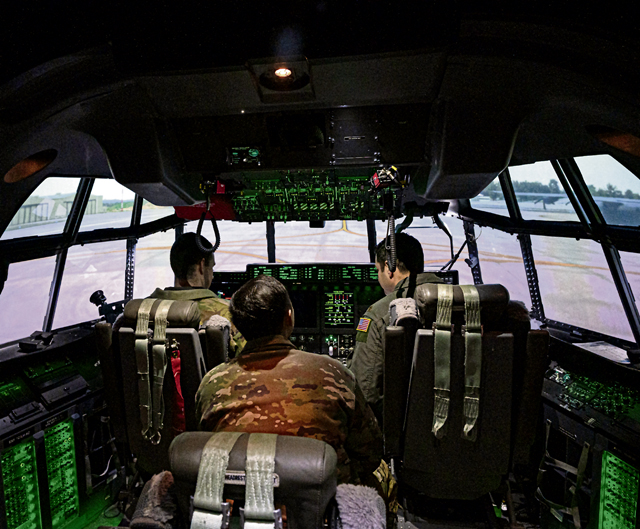
Engine two has caught fire and engine three is hanging on by a thread. Aircrew tries to alleviate the situation. The fire goes out and the crew brings the C-130J Super Hercules aircraft in for landing. It is a struggle to keep control as the heavy plane comes in. Cross winds and inclement weather block their view. They are determined and do not break a sweat. They land the aircraft. After a moment of relief the simulation ends. A disaster brought to life by the 86th Operations Support Squadron Aircraft simulator.
The 86th OSS simulator allows aircrew members to simulate flying a C-130J without the real-life dangers that come with it. This allows them to stay lethal and qualified without ever having to leave the ground.
“We have the C-130J here at Ramstein that we use to support the 37th Airlift Squadron in their training needs,” said U.S. Air Force Lt. Col. Taylor Rigollet, 86th OSS commander. “We are able to train our aircrews on the platform and keep them current and capable of responding to whatever is needed.”
Ramstein Air Base has a unique mission set, which requires some special training sessions to ensure aircrew stay current on their training. The simulator allows this to happen in a controlled environment.
“One of the biggest advantages of the simulator is the safety aspect,” Rigollet said.” We can conduct training without running the risk of losing life or aircraft. It also helps because we can keep members here and do not have to send them elsewhere for training.”
The team at the 86th OSS has multiple ways of testing aircrew and ensuring they can handle whatever is thrown at them.
“There are so many scenarios we can put our aircrew members through,” said Laurie Kuhl, aircraft simulator contracting officer representative. “We put them through a one week course each year where we make them deal with these scenarios without ever leaving the ground. It is satisfying to be a part of their mission and keep them safe and better trained.”
Many electronic devices that people interact with today have software, which means it must be updated and the simulator is no different. However, personnel who maintain the aircraft simulator aren’t just keeping up with it, they’re exceeding expectations.
“We just got an avionics upgrade called block 8.1, which allows us to fly different approaches and have connectivity to the rest of the joint force,” Rigollet said. “We will soon be able to connect to different simulators and fly in formation with aircraft from other U.S. Air Force bases from around the world.”
One of the challenges to flying aircraft is the cost of operation. Fuel, repairs and man-hours can create a large bill to pay, but with the simulator, the 86th OSS can minimize some of those costs.
“To operate a C-130J it can cost approximately $5,000 an hour to fly,” Kuhl said. “The simulator on the other hand costs $850 an hour to operate and has already recouped the $30 million investment to build the simulator with savings alone. We also save the Air Force an additional $350,000 annually by training personnel here at the simulator instead of sending them back to the U.S. for training.”
The usefulness of the simulator for the base is immense. However, with all of the quantifiable factors one thing is not measured and that is the pride it brings to those who operate and train on it.
“I am proud to be able to be a part of this team,” said U.S. Air Force Master Sgt. Desmond Bell, 86th OSS senior enlisted leader. “There are so many great people involved with this facility and for us to be able to keep our aircrew trained and ready means we can continue to do what we need to do to be the best.”


